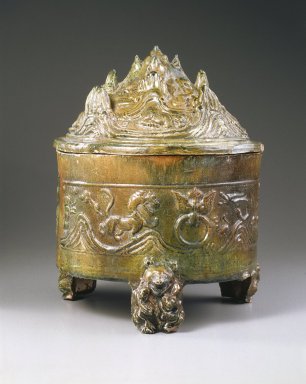
Medium: Earthenware with lead glaze
Geograhical Locations:
Dates:206 B.C.E.–220 C.E.
Dimensions: 11 1/2 x 8 3/4 in. (29.2 x 22.2 cm)
Collections:
Museum Location: Asian Galleries, West, 2nd floor (China)
Exhibitions:
Accession Number: 1995.49a-b
Image: 1995.49a-b_SL1.jpg,
Catalogue Description: The so-called Hill Jar is a well known type of Han dynasty tomb pottery. The present jar shows the typical form of a wide straight sided cylindrical body resting on three legs and covered with a conical top. The body is decorated with a continuous moulded frieze of wild animals and mythical beasts, including bears, boars, and the four directional animals of Chinese mythology (dragon, tiger, phoenix and a tortoise with a snake). On opposite sides of the vessel are two pushou handles, press moulded in low relief showing a stylized animal head holding a ring. There is an inscription moulded in clay body on one side of the jar. The first character reads ju. The second reads ma. The two seams joining the ends of the slab built body are clearly visible on each side of the vessel. The Three press-moulded and carved legs are in the form of grinning bears each clutching two bear cubs. The top is moulded and carved in the form of mountains around a central peak. The mountains are decorated in moulded relief with wild beasts and mythical animals. The top of the jar was fired upside down, allowing the glaze to run and collect at the tops of the mountain peaks. Condition: The Hill Jar and cover are generally intact. On the cover, the glaze is chipped on the tops of three of the mountain peaks and there is a chip on one of the low relief animals. The underside of the vessel, the mouth rim and the rim of the cover all show kiln marks from firing n contact with other vessels. The nose of one bear on one of the legs has been chipped. Many areas of the glaze on the jar and the cover show a slight iridescence from burial. There are identical round adhesive dealer's labels on the bottom of the vessel and the inside cover.